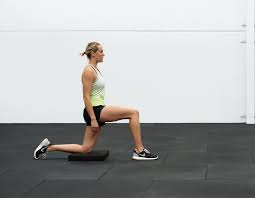It’s no secret that an impressive vertical jump pays dividends in basketball, football and soccer. However, few people have the vertical leap of a Wilt Chamberlain or a LeBron James.
Increasing your jumping capacity requires a combination of strength and velocity. Here are some key tips to help you get your vertical up:
Stretching the Hip Flexors
Many players don’t spend enough time stretching the hip flexors. This is a huge mistake. While it’s a good idea to spend time focusing on quad- and hamstring-focused stretches before Leg Day, it’s just as important to take a moment to stretch the hips, especially the tightest muscle in that group, the iliopsoas.
During this stretch, start with your feet together and arms by your sides, with your back straight. Shift your body weight forward to the right foot, dropping the left knee to the ground so that the shin and upper foot rest on the floor behind you (pictured). Gently press your left elbow into the inside of the right knee to deepen the stretch.
Studies show that static stretches that involve the hip flexor muscles can improve jump performance. However, these stretches should be done in conjunction with dynamic exercises that use the forces of body weight and even more to load the fascia associated with those muscles, mimicking athletic positions and sport movement.
Stretching the Quads
The quadriceps, or “quads,” are a group of four muscles that run down the front of your thigh. They connect to your kneecap through the patellar tendon. The quads are one of the most important muscle groups for running and jumping, as they assist in pushing off the ground and driving forward motion.
Ideally, these muscles should be loose and flexible. Barring structural issues (like joint immobility) and genetic joint limitations (deep hip sockets), the quad muscles should be able to move through their full range of motion without discomfort.
The seated quad stretch is an effective way to accomplish this goal. Find a seat, bench or low table and bring the back leg toward the body to create a 90-degree angle with the knee. Hold this position for the set time. Another great quad stretch is the lying side quad stretch, which can be completed by placing a resistance band around your ankle and leaning against it.
Stretching the Hamstrings
The hamstrings are one of the most important muscles for jumping. The hamstrings are attached to the knee and to the hip, which helps to control the movement of your upper leg (quadriceps).
Stretching the hamstrings can be done both before and after exercise. For pre-workout stretching, try to move into the position quickly and get out of it in two to three seconds. Repeat this several times before getting on with your workout. For post-workout stretches, hold the position for 30 seconds.
To perform a standing hamstring stretch, stand with your legs hip-width apart and place the right foot on a table or bench so that it is slightly flexed. Then, hinge forward from the hips and reach down with your hand to touch the floor or foot — whichever is most comfortable. Be sure not to round the back, which can weaken the hamstring. It’s also best to perform this stretch before a workout, as it can increase hamstring stiffness in the short term.
Stretching the Achilles
Tight calf muscles put extra stress on the Achilles tendon, increasing the risk for injury. One of the best exercises for stretching the Achilles is a heel drop (or double leg heel raise). Stand on the edge of a step and lift your body up by flexing your feet and heels so they slowly drop toward the ground. You should feel a slight tension but not pain during this movement. If you experience pain, stop the stretch.
Another great stretch for the Achilles is the sitting egg, also known as the runner’s heel-sit stretch. This exercise is similar to the heel drop but incorporates strengthening for a doubly effective stretch. To perform this, simply stand with your feet hip-width apart and stagger your feet, placing the affected foot in the back. Then, lean against a wall and bend the front knee to lower your bottom until you feel a low to moderate intensity stretch in the calf of the back foot.
